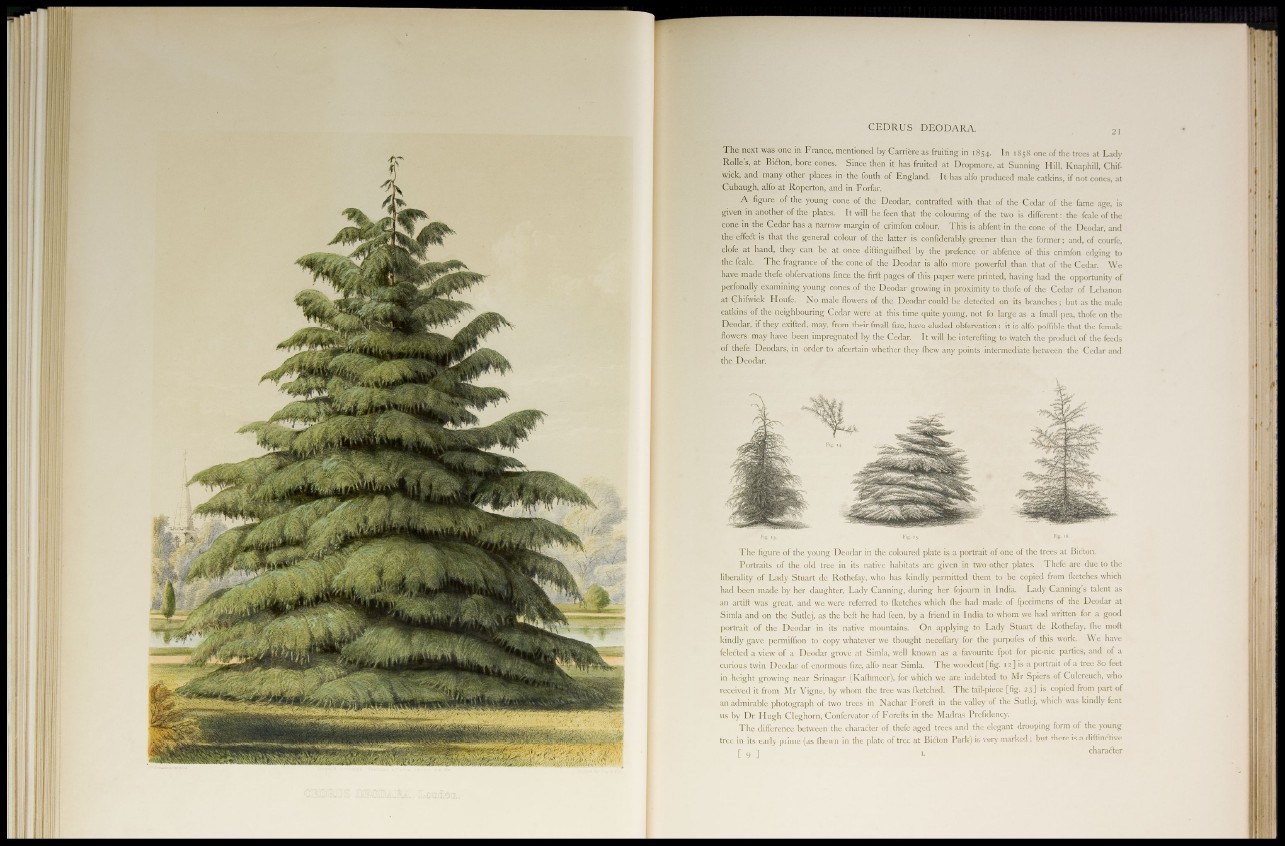
The next was one in France, mentioned by Carrière as fruiting in 1854. In 1858 one of the trees at Lady
Rolle's, at Bicton, bore cones. Since then it has fruited at Dropmore, at Sunning Hill, Knaphill, Chifwick,
and many other places in the fouth of England. It has alfo produced male catkins, if not cones, at
Cubaugh, alfo at Roperton, and in Forfar.
A figure of the young cone of the Deodar, contrafted with that of the Cedar of the fame age, is
given in another of the plates. It will be feen that the colouring of the two is different: the fcale of the
cone in the Cedar has a narrow margin of crimfon colour. This is abfent in the cone of the Deodar, and
the effect is that the general colour of the latter is confidently greener than the former ; and, of courfe,
clofe at hand, they can be at once diftinguifhed by the prefence or abfence of this crimfon edging to
the fcale. The fragrance of the cone of the Deodar is alfo more powerful than that of the Cedar. We
have made thefe obfervations fince the firft pages of this paper were printed, having had the opportunity of
perfonally examining young cones of the Deodar growing in proximity to thofe of the Cedar of Lebanon
at Chifwick Houfe. No male flowers of the Deodar could be deteded on its branches ; but as the male
catkins of the neighbouring Cedar were at this time quite young, not fo large as a fmall pea, thofe on the
Deodar, if they exifted, may, from their fmall fize, have eluded obfervation : it is alfo poffible that the female
flowers may have been impregnated by the Cedar. It will be interefting to watch the product of the feeds
of thefe Deodars, in order to afcertain whether they fliew any points intermediate between the Cedar and
the Deodar.
Fig. 13. Fig. iS. Fig. 16.
The figure of the young Deodar in the coloured plate is a portrait of one of the trees at Bicton.
Portraits of the old tree in its native habitats are given in two other plates. Thefe are due to the
liberality of Lady Stuart de Rothefay, who has kindly permitted them to be copied from (ketches which
had been made by her daughter, Lady Canning, during her fojourn in India. Lady Canning's talent as
an artift was great, and we were referred to (ketches which (lie had made of fpecimens of the Deodar at
Simla and on the Sutlej, as the beft he had feen, by a friend in India to whom we had written for a good
portrait of the Deodar in its native mountains. On applying to Lady Stuart de Rothefay, (be moft
kindly gave permiffion to copy whatever we thought neceffary for the purpofes of this work. We have
feletfed a view of a Deodar grove at Simla, well known as a favourite fpot for pic-nic parties, and of a
curious twin Deodar of enormous fize, alfo near Simla. The woodcut [fig. 12] is a portrait of a tree 80 feet
in height growing near Srinagar (Kaflimeer), for which we are indebted to Mr Spiers of Culcreuch, who
received it from Mr Vigne, by whom the tree was fketched. The tail-piece [fig. 23] is copied from part of
an admirable photograph of two trees in Nachar Foreft in the valley of the Sutlej, which was kindly fent
us by Dr Hugh Cleghorn, Confervator of Forefts in the Madras Prefidency.
The difference between the character of thefe aged trees and the elegant drooping form of the young
tree in its early prime (as (hewn in the plate of tree at Bidon Park) is very marked; but there is a diftindtive
[- 9 j L character